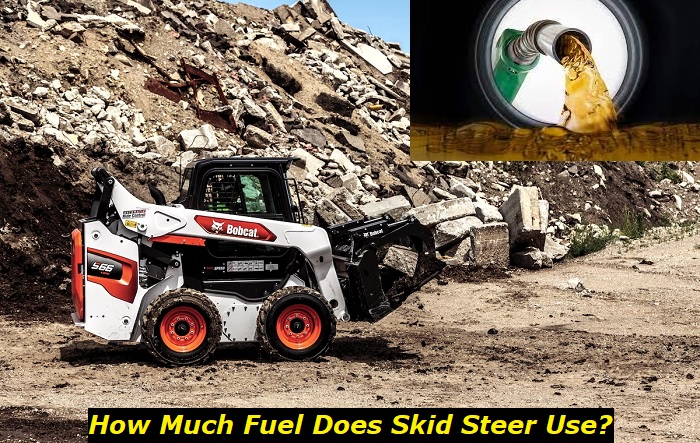How Much Fuel Does a Skid Steer Use Per Hour? Our Research
Skid steers are highly maneuverable machines with utility in lightweight tasks and significant industrial work. Most skid steers use internal combustion engines that burn either gasoline or diesel to power them on. Besides the nominal cost of purchasing or renting a skid steer, a significant recurrent cost for using a skid steer is what is spent on fueling it.
You should know how much you must spend operating a skid steer. Moreso when you factor in increases in fuel cost. Thus, figuring out how much fuel a skid steer uses per hour is our focus. Also outlined are methods for improving a skid steer's fuel efficiency.

Skid Steer Fuel Usage Per Hour
A skid steers fuel use per hour depends on several factors, including the manufacturer, model, engine size, fuel system, and more. The conditions in which you use the skid steer and the workload also have a significant effect on the fuel consumption of the machine.
When measuring skid steer fuel consumption, the typical unit of measurement is Gallons Per Hour. On a gallon-per-hour measure, most skid steers consume between 1 to 10 gallons of fuel per hour. For example, a bobcat s850 with an 1850-pound rated operating capacity uses between 3.5 to 6.5 gallons per hour under normal operating conditions.
Under normal conditions, a Gehl v420 that has a 120 horsepower (hp) engine with a rated operating capacity of 4200 pounds will consume 4 to 7 gallons per hour. A Kubota SSV6 will consume 3.5 to 5.5 gallons per hour. A Cat 226B Series 3 can use up to 9.9 gallons per hour under normal operating conditions.
As shown, there is no singular figure for a skid steers fuel consumption; it differs based on several characteristics and the nature and condition of work you use it for. Generally, you should expect a fuel consumption per hour between 1 and 10 gallons depending on the particular type of skid steer you use and the kind of work you put it through.
Improving a Skid Steer's Fuel Efficiency
Discussed in this section are things you can do to improve the fuel efficiency of your skid steer.
1) Optimize Work Process
An excellent way to reduce the fuel consumption of your skid steer is to optimize your workdays efficiently with proper planning. There are certain operations that can be batched together instead of doing them in bits.
For example, if you have a number of materials like wood you need to transport from one location to the other, it makes sense to first gather as much of that material together before transporting it collectively with the skid steer. Instead, some operators, in a bid to remain active, transport materials in bits as soon as they are available, which increases the time the machine is in operation and fuel consumption.
2) Regular Maintenance
To get excellent fuel efficiency from your engine, it needs to run optimally. For optimal performance of your skid steers engine, you need to maintain or tune it up regularly. A lot of fuel consumption problems tend to result from maintenance-related issues. When you miss scheduled maintenance that includes things like component inspections, lubrication, and air filter and oil changes, it affects the machine's fuel efficiency.
To improve or maintain fuel efficiency, keep your engine running well by adhering to scheduled maintenance intervals. Also, repair any issues detected as soon as possible. Low compression, air filter damage, and misfiring spark plugs can lead to an increase in your skid steer's fuel consumption.
3) Reduce Idling
Another thing you should implement is shutting off the engine when not in use. Over a period of time, putting off the engine when not in use will reduce the fuel consumption of your skid steer. Running the engine idly between breaks, when resting or waiting, will add unnecessary fuel costs to you or your business.
4) Use High-Quality Fuel
The quality of fuel you use in your skid steer is critical to how well and efficiently it burns fuel. Adulterated fuels will not burn as well as needed and will likely lead your engine to wear faster. A worn engine is unlikely to be fuel efficient. So, to ensure that your skid steer burns fuel efficiently, use the fuels recommended by the manufacturer and buy from reputable dealers.
5) Do Not Overload the Skid Steer
It is not uncommon to hear skid steer and other heavy machine operators brag about how their equipment can carry more load than it's rated for. Firstly, this is a dangerous thing to do as you risk tipping the skid steer over, wearing it out faster, damaging it, and even causing human injury. As it concerns our focus, lifting additional weight with your skid steer will put tremendous strain on the engine and increase fuel consumption.
If you are guilty of overloading your skid steer, that's one reason why fuel consumption may be excessive in your case. To reduce heavy consumption, stop overloading your skid steer.
6) Don't Speed
You might have heard that "slow and steady wins the race." Here slow and steady reduces fuel consumption. As you increase the driving speed, the skid steer has to resist more air which leads to an increment in the engine's work and fuel consumption to maintain the pace. Driving the skid steer at high speeds will use up more fuel than at a lower speed along the same distance. As a bonus, driving at slower speeds reduces the risks of accidents.
Further, avoid quick acceleration as fast starts use more fuel than slower ones.
7) Maintain Inflated Tires
Tires that are not adequately inflated can lead to increased fuel consumption of your skid steer. Underinflated tires have rolling resistance. With more rolling resistance, the engine has to expend more energy to keep the skid steer moving. To reduce this effect, check tire pressure frequently and keep them inflated.
8) Make Intelligent buys
When comparing machines with similar technologies or from the same era, the bigger, higher-horsepower ones tend to use more fuel than the smaller ones. A large skid steer has its advantages, including a higher-rated operating and lifting capacity. However, the benefits of an enormous skid steer will not accrue to people who don't need it. Creating a disadvantage regarding fuel consumption.
So, if you are thinking of getting a new skid steer, think deeply about the kind of work you intend to do and buy the right-sized machine for that purpose. It will be incredibly wasteful for several reasons, including fuel consumption, to underutilize a skid steer.
Conversely, do not buy a smaller machine than the work you intend to do. As we discussed when talking about overloading, carrying more load than your machine is rated for will stress the engine and increase fuel consumption.
9) Upgrade Your Skid Steer
Sometimes newer is better, and the best way to improve the fuel efficiency of your skid steer might just be to get a new one. You may be reluctant to upgrade your old skid steer because of the costs of getting a new one. Similarly, you may be tempted to purchase an older skid steer because of its comparably lower costs. While such reasoning is valid, in the long term, it might be more trouble than its worth in terms of availability of support, rareness of parts, and efficiency, including fuel consumption.
Newer machines tend to come with a plethora of upgrades, and the gap in efficiency between two machines widens with the age disparity between them. For example, it is possible to get a newer skid steer with a smaller engine that outputs more power, can handle more intense tasks, and uses less fuel than an older one. For instance, machines with electric fuel injectors are significantly more efficient than older carburetor-based ones.
You can go a step further and abandon fuel-powered skid steers altogether and get a fully electric skid steer. Although they also come with their own caveats, for example, limited runtime due to long battery recharge times. A good middle ground is a hybrid skid steer.
Conclusion
A skid steer's fuel use per hour is a significant part of the cost of operating one. We set out to find out how much a skid steer uses per hour. Our answer; they use between 1 and 10 gallons of fuel per hour. However, fuel consumption depends on several factors. Some things that can affect skid steer fuel use include its make and model, the engine size, and the fuel injection system. Also, the conditions and type of work you use it for have an effect on the fuel use of a skid steer.
Also outlined are ways to improve the fuel efficiency of a skid steer. You should optimize your work process, regularly maintain the skid steer, reduce idling and use high-quality fuel. Also, do not overload the skid steer, speed, or drive underinflated tires. If you don't yet own a skid steer, do a proper evaluation of the type of work you will do before purchasing one. In some cases, you just need a newer skid steer.

Add comment